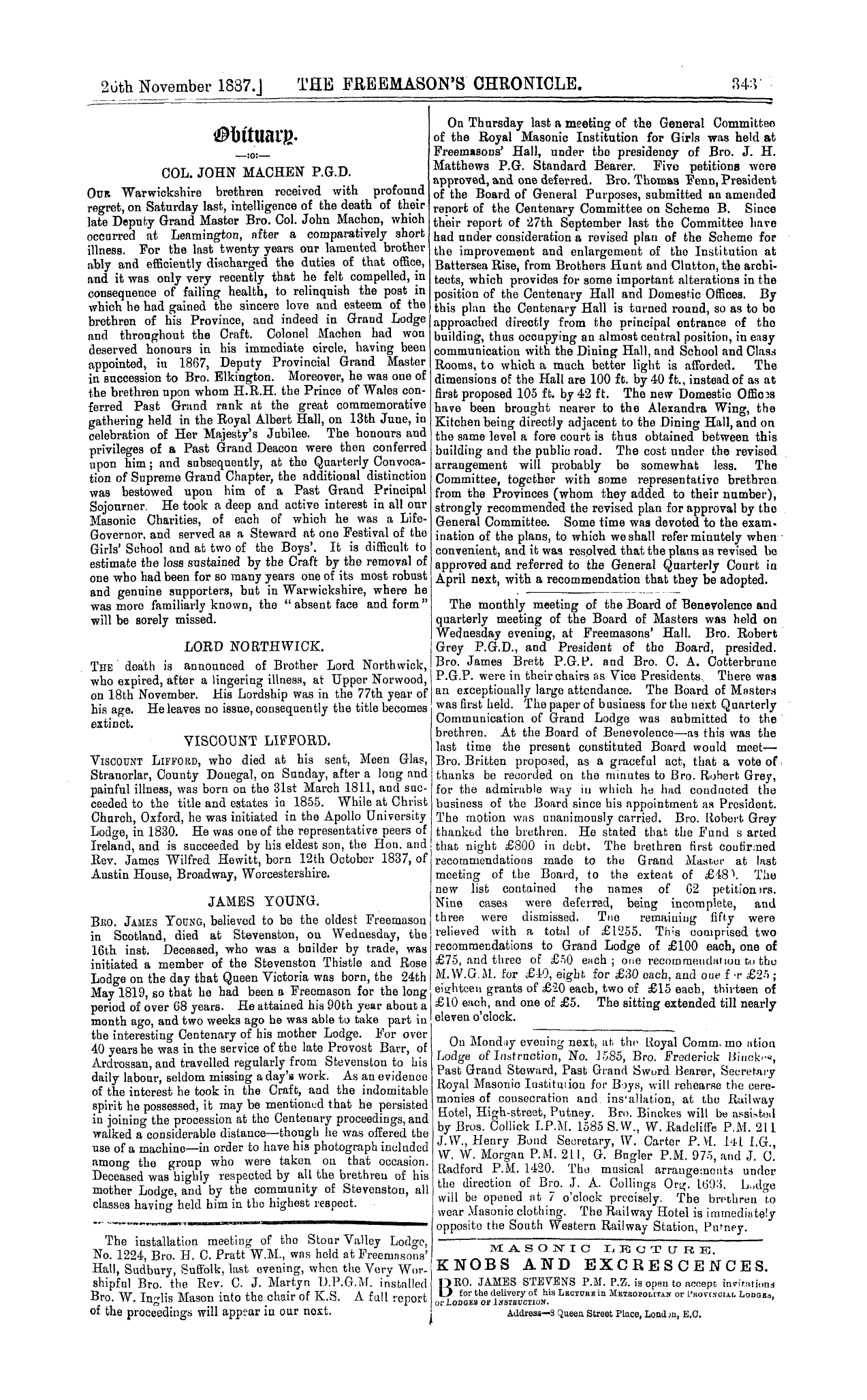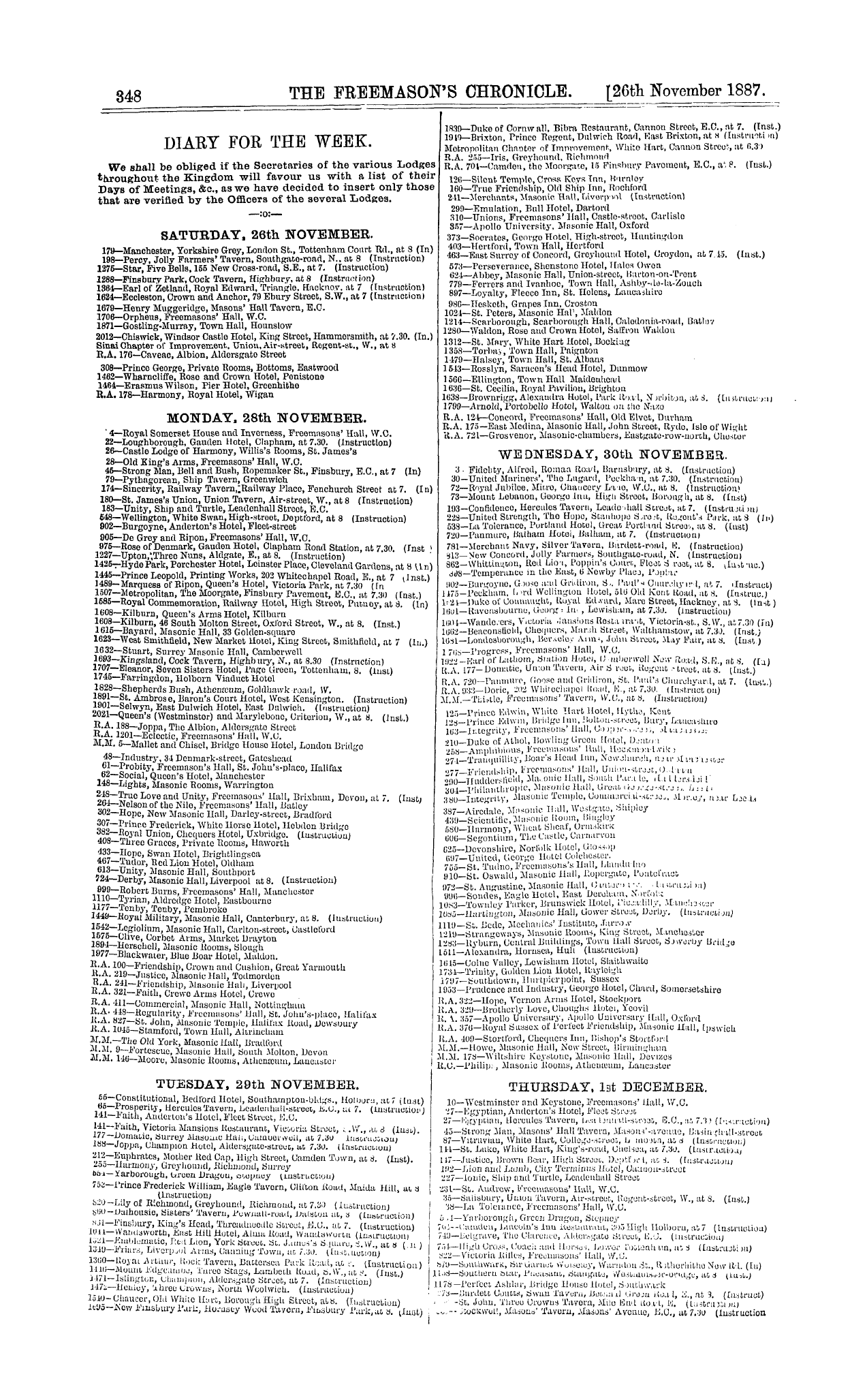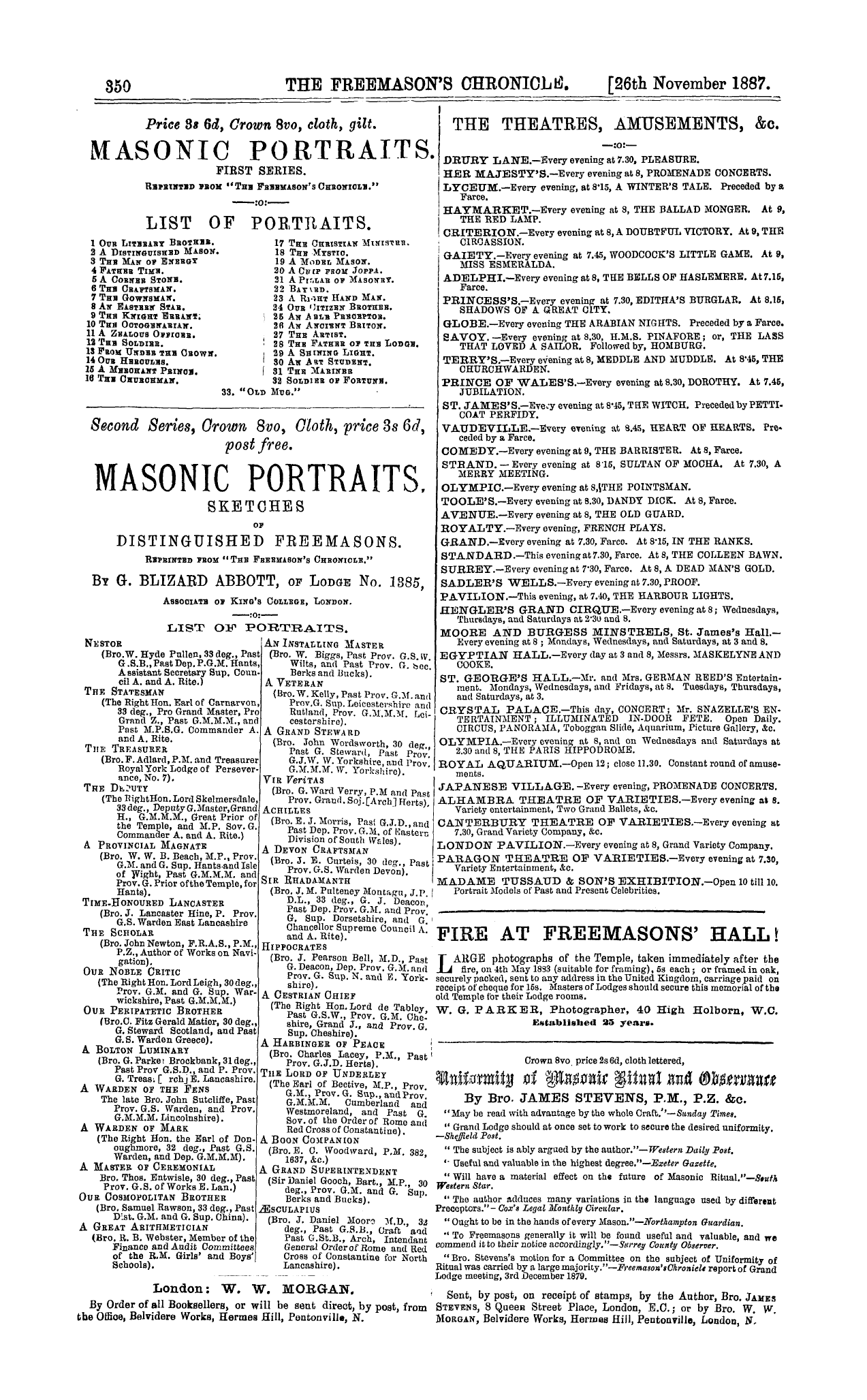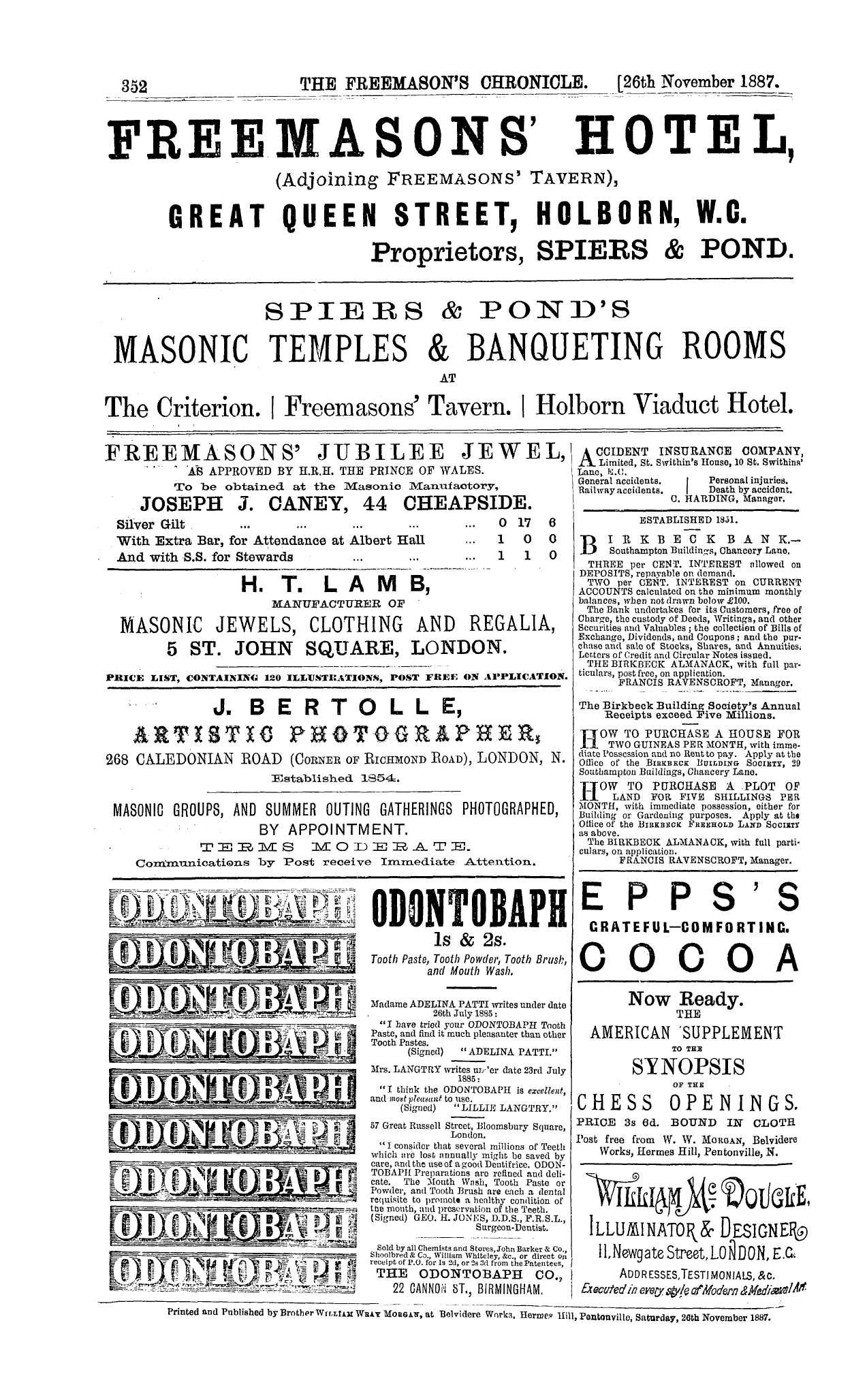-
Articles/Ads
Article THE NEW PHILADELPHIA THEORY. ← Page 2 of 3 Article THE NEW PHILADELPHIA THEORY. Page 2 of 3 →
Note: This text has been automatically extracted via Optical Character Recognition (OCR) software.
The New Philadelphia Theory.
tuted at the close of the year 1730 , or the beginning of the year 1731 , with thirteen members . . . . Now the point I wish to submit for your consideration is the following one . Is it not as reasonable to conjecture that St . John ' s Lodge had existed before February 1731 ?
...First of all , is there any evidence , aliunde , of the existence of Masonic Lodges in Philadelphia before 1731 ? There is ; in the Pennsylvania Gazette , No . 108 , 8 th December 1730 , printed by Benjamin Franklin , is the following notice : —
" As there are several Lodges of Freemasons in this Province , and people have lately been much amused with conjectures concerning them , we think the following account of Freemasonry from London will not be unacceptable to the reader . "
" Here then [ says Bro . Gould ] the fact of there being in 1730 , not one only , but several Lodges at work in the Province , is satisfactorily established , " Having satisfied himself that Franklin ' s statement was a bona fide fact , my good Brother then proceeded with speculating and guessing , that whereas Gibraltar had a Lodge in 1728 , so
may Pennsylvania have had Lodges even before 1728 . In
short , it seems that Bro . Gould has forgotten the noble lessons he himself taught in his History of Freemasonry , and has gone back to the old Masonic luminary style of
reasoning and proving . Bro . Gould ought to know that with such a method of reasoning , a man may prove that the moon was made of green cheese . Now , with the same method of reasoning you shall see what I can prove .
First , there is no doubt that , in 1620 , when the Puritans started for America , that both in England and in Scotland the Masons had an entire monopoly of the Masons' trade , that is , an uninitiated bricklayer could not have got
employment any how ; this- " being satisfactorily established , " it " undoubtedly" follows , that the bricklayers that came here in the Mayflower , in 1620 , were all initiated into tho Masonic mysteries ; "if so , " then our ancient Puritan
brethren " undoubtedly took with them their Masonic paraphernalia , and I may be permitted to conjecture that , daring the tedious passage of four months , they held Masonic meetings on the Mayflower , and who knows
whether the pious Brewster , Bradford , Carver , Cushman , Winslow , Standish , and all the male Puritans on the Mayflower , were notMasonized dnring their passage across the Atlantic ; any how , Masonry in Massachusetts was " undoubtedly " coeval with the landing of the Puritans
in 1620 . On the other hand , the Quakers did not land on the banks of the Delaware before about 1680 . Then the Masons' monopoly in England existed no longer ; the Quaker Masons did not dare to ride the Masons goat ;
even those that were Masomzed before they were •Quakerized carried no Masonic paraphernalia with them to America ; hence , while Massachusetts was blessed with Masonic Lodges as early as 1620 , Pennsylvania was
unblessed until 1731 , or , it may be ( if Bro . Gould is right ) in 1728 . And what then ? Why ! Masonry in Pennsylvania was a baby when the Boston Lodge was a full-grown damsel of nearly one hundred years of age .
Second , the old Puritans were more tenacious of preserving English notions than the Pennsylvanian Quakers ever were . For instance , the Puritans called
their country " New England "; their towns were named after English towns , viz .: Plymouth , Ipswich , Boston , Dorchester , Roxbury , & c . In Boston , the earliest streets
were called Cornhill , King Street , & c . A glance at the
map of Boston , will convince any one that it was designed te resemble dear old London . The Boston streets are beautifully crooked and zigzag ; it had alleys , lanes , and courts within courts , the street corners were angles of
all imaginable degrees ; in short , Boston was a regular " maze , " and about forty years ago , it was not at all uncommon for a stranger , when he left the old National Theatre at night , after an hour ' s walk , to sometimes find
himself back again at the door of the same theatre . Moreover , we all know that the Puritans imitated the old English fashion of hanging Nonconformists , burning of witches , < fec . To show still further their love of everything
that was English , I must inform my English readers that the settlement of Boston began in 1630 , and in 1638 , as soon as they could muster a small squad , they called it
" The Ancient and Honourable Artillery Company , " and that Artillery Company , as well as its old Masonic Lodge , are preserved unto this day ; indeed , that Lodge was formerly called " The Holy Exquisite Lodge of St . John . "
The New Philadelphia Theory.
any evidence of the Philadelphia Quakers ever having had any love for anything that was peculiarly English ? Their towns and streets were named un-English , the map of
Franklin " undoubtedly " was acquainted with the name of the said Lodge when he left Boston in 1723 , and Franklin " undoubtedly , " in 1731 , named the Philadelphia Lodge after the Boston Lodge . Now , in the name of common sense T ask , whether there is
Philadelphia is un-English ; they did not burn witches , or hang up Quakers , they had no Ancient and Honourable Artillery Company , and , of course , they could not have cared for English Masonry .
But here is something still more curious . My friend Bro . David Pulsifer , the Boston Antiquary , whose name I have mentioned in former communications , was employed
by the State of Massachusetts , some years ago , to copy , compile and edit some old documents , among which he found a letter dated 1654 , page 137 , containing the following order , viz .: — " We desire that one psell of the goods now sent , marked and numbered as in the margin , may be deliuered
vnto Mr . John Eliot , " —21 March 1654 * The mark alluded to is a Mason's Mark . Hence Bro . Pulsifer copied it , and had it engraved . When Bro . John T . Heard , a P . G . M . of Massachusetts , saw this mark he
also took a copy thereof , for the purpose of proving by it the antiquity of Masonry in Massachusetts . I have seen the mark , and there is no doubt that it is a Mason ' s mark Hence John Eliot , the " Apostle to the Indians , " was a
brother Mason , and hence he was " undoubtedly" a member of the old Boston Lodge . So we see that Boston had an old Lodge before Philadelphia was dreamed of . And this is not all . It is indisputable that Jonathan
Belcher was Masonised early in the 18 th century , in London . The learned Bro . John D . Caldwell G . Sec . of Ohio , in the Report of the Proceedings of his Grand Lodge for 1874 , headed , page 10 , with capital letters , viz ., " Our Masonic Brother Jonathan , " and went on to say : —
' In the spring of 1700 , in his twentieth birth year , young Jonathan [ Belcher ] bade good-bye to his indulgent parents , and the ambitious youth sailed for the port of
Liverpool . On reaching London , his social position and graces gave him entree into refined society of the city and universities , and to the Court of King William III .
This monarch had been privately initiated into Masonry by the venerable architect Sir Christopher Wren , and became enthusiastic in what now is termed the ' Royal
Art . ' So much so as to preside in a Lodge specially erected for him in the regal apartments of Hampton Court , where he and his favourites spent many festive hours .
" Young Yankee and Old Architect affiliated admirably . Young Curious and Old Curiosity became consorts at
once . " The young merchant qualified himself in the then rude rituals , and rapturously relished the conversation and teachings in architecture rehearsed by Sir Christopher .
" In 1702 , the year Jonathan became a Mason , the King , having fallen from a horse in Bushey Park , died , and the Court were in mourning ; of those in the funeral array none attracted more attention , as , clothed with a Masonic
collar and jewel , he left Kensington Palace for the sepulture of royalty in the Chapel of Henry VII ., Westminster ; the people eagerly pointed out the American [ exclaiming ] , That is Brother Jonathan , so familiarly called by the King .
" It does not transpire what this cultured Mason did in planting of the then Royal Art at his home . It is fair to presume that a Lodge was working there [ in Boston ] long before 1733 . Again , this is not all . The late Bro . C . W . Moore , " the
greatest Masonic authority in the world , " as he was styled all over America , wrote a History of Freemasonry , in 1829 , and in the third , volume of his work , after quoting from
Preston , the law that in future Lodges must be provided with Charters , goes on to state : " The first Lodge for this country was received about the year 1720 . It was a Dispensation authority [ for ] the
opening of a Lodge in this city [ Boston ] . We have the fact from a clergman of the Church of England ( the late Rev . Mr . Montague , formerly of Dedham ) , who found it stated in an old document in the archives of King ' s Chapel
Note: This text has been automatically extracted via Optical Character Recognition (OCR) software.
The New Philadelphia Theory.
tuted at the close of the year 1730 , or the beginning of the year 1731 , with thirteen members . . . . Now the point I wish to submit for your consideration is the following one . Is it not as reasonable to conjecture that St . John ' s Lodge had existed before February 1731 ?
...First of all , is there any evidence , aliunde , of the existence of Masonic Lodges in Philadelphia before 1731 ? There is ; in the Pennsylvania Gazette , No . 108 , 8 th December 1730 , printed by Benjamin Franklin , is the following notice : —
" As there are several Lodges of Freemasons in this Province , and people have lately been much amused with conjectures concerning them , we think the following account of Freemasonry from London will not be unacceptable to the reader . "
" Here then [ says Bro . Gould ] the fact of there being in 1730 , not one only , but several Lodges at work in the Province , is satisfactorily established , " Having satisfied himself that Franklin ' s statement was a bona fide fact , my good Brother then proceeded with speculating and guessing , that whereas Gibraltar had a Lodge in 1728 , so
may Pennsylvania have had Lodges even before 1728 . In
short , it seems that Bro . Gould has forgotten the noble lessons he himself taught in his History of Freemasonry , and has gone back to the old Masonic luminary style of
reasoning and proving . Bro . Gould ought to know that with such a method of reasoning , a man may prove that the moon was made of green cheese . Now , with the same method of reasoning you shall see what I can prove .
First , there is no doubt that , in 1620 , when the Puritans started for America , that both in England and in Scotland the Masons had an entire monopoly of the Masons' trade , that is , an uninitiated bricklayer could not have got
employment any how ; this- " being satisfactorily established , " it " undoubtedly" follows , that the bricklayers that came here in the Mayflower , in 1620 , were all initiated into tho Masonic mysteries ; "if so , " then our ancient Puritan
brethren " undoubtedly took with them their Masonic paraphernalia , and I may be permitted to conjecture that , daring the tedious passage of four months , they held Masonic meetings on the Mayflower , and who knows
whether the pious Brewster , Bradford , Carver , Cushman , Winslow , Standish , and all the male Puritans on the Mayflower , were notMasonized dnring their passage across the Atlantic ; any how , Masonry in Massachusetts was " undoubtedly " coeval with the landing of the Puritans
in 1620 . On the other hand , the Quakers did not land on the banks of the Delaware before about 1680 . Then the Masons' monopoly in England existed no longer ; the Quaker Masons did not dare to ride the Masons goat ;
even those that were Masomzed before they were •Quakerized carried no Masonic paraphernalia with them to America ; hence , while Massachusetts was blessed with Masonic Lodges as early as 1620 , Pennsylvania was
unblessed until 1731 , or , it may be ( if Bro . Gould is right ) in 1728 . And what then ? Why ! Masonry in Pennsylvania was a baby when the Boston Lodge was a full-grown damsel of nearly one hundred years of age .
Second , the old Puritans were more tenacious of preserving English notions than the Pennsylvanian Quakers ever were . For instance , the Puritans called
their country " New England "; their towns were named after English towns , viz .: Plymouth , Ipswich , Boston , Dorchester , Roxbury , & c . In Boston , the earliest streets
were called Cornhill , King Street , & c . A glance at the
map of Boston , will convince any one that it was designed te resemble dear old London . The Boston streets are beautifully crooked and zigzag ; it had alleys , lanes , and courts within courts , the street corners were angles of
all imaginable degrees ; in short , Boston was a regular " maze , " and about forty years ago , it was not at all uncommon for a stranger , when he left the old National Theatre at night , after an hour ' s walk , to sometimes find
himself back again at the door of the same theatre . Moreover , we all know that the Puritans imitated the old English fashion of hanging Nonconformists , burning of witches , < fec . To show still further their love of everything
that was English , I must inform my English readers that the settlement of Boston began in 1630 , and in 1638 , as soon as they could muster a small squad , they called it
" The Ancient and Honourable Artillery Company , " and that Artillery Company , as well as its old Masonic Lodge , are preserved unto this day ; indeed , that Lodge was formerly called " The Holy Exquisite Lodge of St . John . "
The New Philadelphia Theory.
any evidence of the Philadelphia Quakers ever having had any love for anything that was peculiarly English ? Their towns and streets were named un-English , the map of
Franklin " undoubtedly " was acquainted with the name of the said Lodge when he left Boston in 1723 , and Franklin " undoubtedly , " in 1731 , named the Philadelphia Lodge after the Boston Lodge . Now , in the name of common sense T ask , whether there is
Philadelphia is un-English ; they did not burn witches , or hang up Quakers , they had no Ancient and Honourable Artillery Company , and , of course , they could not have cared for English Masonry .
But here is something still more curious . My friend Bro . David Pulsifer , the Boston Antiquary , whose name I have mentioned in former communications , was employed
by the State of Massachusetts , some years ago , to copy , compile and edit some old documents , among which he found a letter dated 1654 , page 137 , containing the following order , viz .: — " We desire that one psell of the goods now sent , marked and numbered as in the margin , may be deliuered
vnto Mr . John Eliot , " —21 March 1654 * The mark alluded to is a Mason's Mark . Hence Bro . Pulsifer copied it , and had it engraved . When Bro . John T . Heard , a P . G . M . of Massachusetts , saw this mark he
also took a copy thereof , for the purpose of proving by it the antiquity of Masonry in Massachusetts . I have seen the mark , and there is no doubt that it is a Mason ' s mark Hence John Eliot , the " Apostle to the Indians , " was a
brother Mason , and hence he was " undoubtedly" a member of the old Boston Lodge . So we see that Boston had an old Lodge before Philadelphia was dreamed of . And this is not all . It is indisputable that Jonathan
Belcher was Masonised early in the 18 th century , in London . The learned Bro . John D . Caldwell G . Sec . of Ohio , in the Report of the Proceedings of his Grand Lodge for 1874 , headed , page 10 , with capital letters , viz ., " Our Masonic Brother Jonathan , " and went on to say : —
' In the spring of 1700 , in his twentieth birth year , young Jonathan [ Belcher ] bade good-bye to his indulgent parents , and the ambitious youth sailed for the port of
Liverpool . On reaching London , his social position and graces gave him entree into refined society of the city and universities , and to the Court of King William III .
This monarch had been privately initiated into Masonry by the venerable architect Sir Christopher Wren , and became enthusiastic in what now is termed the ' Royal
Art . ' So much so as to preside in a Lodge specially erected for him in the regal apartments of Hampton Court , where he and his favourites spent many festive hours .
" Young Yankee and Old Architect affiliated admirably . Young Curious and Old Curiosity became consorts at
once . " The young merchant qualified himself in the then rude rituals , and rapturously relished the conversation and teachings in architecture rehearsed by Sir Christopher .
" In 1702 , the year Jonathan became a Mason , the King , having fallen from a horse in Bushey Park , died , and the Court were in mourning ; of those in the funeral array none attracted more attention , as , clothed with a Masonic
collar and jewel , he left Kensington Palace for the sepulture of royalty in the Chapel of Henry VII ., Westminster ; the people eagerly pointed out the American [ exclaiming ] , That is Brother Jonathan , so familiarly called by the King .
" It does not transpire what this cultured Mason did in planting of the then Royal Art at his home . It is fair to presume that a Lodge was working there [ in Boston ] long before 1733 . Again , this is not all . The late Bro . C . W . Moore , " the
greatest Masonic authority in the world , " as he was styled all over America , wrote a History of Freemasonry , in 1829 , and in the third , volume of his work , after quoting from
Preston , the law that in future Lodges must be provided with Charters , goes on to state : " The first Lodge for this country was received about the year 1720 . It was a Dispensation authority [ for ] the
opening of a Lodge in this city [ Boston ] . We have the fact from a clergman of the Church of England ( the late Rev . Mr . Montague , formerly of Dedham ) , who found it stated in an old document in the archives of King ' s Chapel















